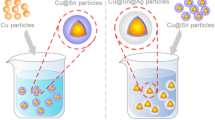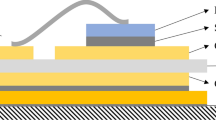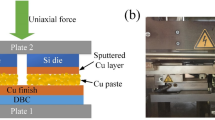Abstract
With the development of electronic technology towards high power, miniaturization, and system integration, power electronic packaging is facing increasing challenges, especially for die attachment. This research aims to explore silver-coated copper (Cu@Ag) paste with sufficient mechanical properties and high-temperature reliability, as an alternative solution for silver sintering with lower cost. Firstly, micro-Cu@Ag sintering pastes were investigated under four kinds of polyol-based solvent systems and two types of particle morphologies, which included sphere-type (SCu@Ag) and flake-type (FCu@Ag). Sintering performance and microstructural evolution were compared and analyzed. Notably, sintered joints employing the terpineol–polyethylene glycol solvent system and flake-type morphology displayed a denser microstructure in comparison to SCu@Ag joints. Its bonding strength reached 36.15 MPa, which was approximately 20% higher than SCu@Ag joints. Subsequently, the influence of key sintering process parameters on Cu@Ag joints was analyzed, including sintering temperature, pressure and time. Additionally, high-temperature aging and thermal cycling tests were conducted on the optimized Cu@Ag joints to assess their reliability. Finally, the micromechanical properties of Cu@Ag joints before and after high-temperature aging were further evaluated by nanoindentation including creep properties. The elastoplastic constitutive models of Cu@Ag sintered materials with different particle morphologies were constructed, providing valuable insights for reliability evaluation. The results indicated that FCu@Ag joints exhibited satisfactory creep resistance and high-temperature reliability. In conclusion, the FCu@Ag micro-paste based on the terpineol–polyethylene glycol solvent system proposed in this study demonstrated sufficient bonding strength, high reliability, and adequate mechanical properties as an attractive solution for high-temperature power electronics packaging.



















Similar content being viewed by others
Data availability
The data that support the finding of this study are available from the corresponding author upon reasonable request.
References
A. Roshanghias, P. Malago, J. Kaczynski et al., Energies (2021). https://doi.org/10.3390/en14082176
V.R. Manikam, C. Kuan Yew, IEEE Trans. Compon. Packag. Manuf. Technol. (2011). https://doi.org/10.1109/tcpmt.2010.2100432
S. Zhang, X. Xu, T. Lin, P. He, J. Mater. Sci. (2019). https://doi.org/10.1007/s10854-019-01790-3
N. Jiang, L. Zhang, Z.Q. Liu et al., Sci. Technol. Adv. Mater. (2019). https://doi.org/10.1080/14686996.2019.1640072
M. Xiong, L. Zhang, J. Mater. Sci. (2018). https://doi.org/10.1007/s10853-018-2907-y
Z. Zhang, C. Chen, Y. Yang et al., J. Alloys Compd. (2019). https://doi.org/10.1016/j.jallcom.2018.11.251
S.K. Bhogaraju, O. Mokhtari, F. Conti, G. Elger, Scr. Mater. (2020). https://doi.org/10.1016/j.scriptamat.2020.02.045
P. Zhao, X. Li, Y. Mei, G.-Q. Lu, Mater. Lett. (2022). https://doi.org/10.1016/j.matlet.2021.131603
K.S. Siow, J. Electron. Mater. (2014). https://doi.org/10.1007/s11664-013-2967-3
J. Liu, H. Chen, H. Ji, M. Li, ACS Appl. Mater. Interfaces (2016). https://doi.org/10.1021/acsami.6b10280
Y. Peng, Y. Mou, J. Liu, M. Chen, J. Mater. Sci. (2020). https://doi.org/10.1007/s10854-020-03380-0
H. Fang, C. Wang, S. Zhou et al., J. Mater. Sci. (2020). https://doi.org/10.1007/s10854-020-03207-y
L.D. Carro, A.A. Zinn, P. Ruch, F. Bouville, A.R. Studart, T. Brunschwiler, J. Electron. Mater. (2019). https://doi.org/10.1007/s11664-019-07452-8
Y. Mou, J. Liu, H. Cheng, Y. Peng, M. Chen, JOM (2019). https://doi.org/10.1007/s11837-019-03517-5
C.H. Lee, E.B. Choi, J.-H. Lee, Scr. Mater. (2018). https://doi.org/10.1016/j.scriptamat.2018.02.029
E.B. Choi, J.-H. Lee, Appl. Surf. Sci. (2021). https://doi.org/10.1016/j.apsusc.2021.149156
Y. Tian, Z. Jiang, C. Wang et al., RSC Adv. (2016). https://doi.org/10.1039/c6ra16474a
T. Michaud, T. Baffie, S.S. Nobre, J.-M. Missiaen, D. Bouvard, J.-P. Simonato, Materialia (2020). https://doi.org/10.1016/j.mtla.2020.100871
C.-H. Hsiao, W.-T. Kung, J.-M. Song, J.-Y. Chang, T.-C. Chang, Mater. Sci. Eng. (2017). https://doi.org/10.1016/j.msea.2016.12.084
Y. Bao, A. Wu, H. Shao, Y. Zhao, L. Liu, G. Zou, J. Mater. Sci. (2018). https://doi.org/10.1007/s10853-018-2809-z
H. Zhang, W. Wang, H. Bai et al., J. Alloys Compd. (2019). https://doi.org/10.1016/j.jallcom.2018.10.067
X. Long, Y. Guo, Y. Su, K.S. Siow, C. Chen, J. Mater. Sci. (2022). https://doi.org/10.1007/s10854-021-07474-1
X. Long, Q.P. Jia, Z. Li, S.X. Wen, Int. J. Solids Struct. (2020). https://doi.org/10.1016/j.ijsolstr.2020.01.014
G. He, W. Hongcheng, Y. Yao, J. Mater. Sci. (2021). https://doi.org/10.1007/s10853-021-06426-8
X. Long, Q. Jia, Z. Shen, M. Liu, C. Guan, Mech. Mater. (2021). https://doi.org/10.1016/j.mechmat.2021.103881
H. Zhang, Y. Liu, L. Wang, F. Sun, X. Fan, G. Zhang, Results Phys. (2019). https://doi.org/10.1016/j.rinp.2018.12.026
J. Fan, D. Jiang, H. Zhang et al., Results Phys. (2022). https://doi.org/10.1016/j.rinp.2021.105168
W.C. Oliver, G.M. Pharr, J. Mater. Res. Technol. (1992). https://doi.org/10.1557/jmr.1992.1564
K. Tunvisut, N.P. O’Dowd, E.P. Busso, Int. J. Solids Struct. (2001). https://doi.org/10.1016/S0020-7683(00)00017-2
J. Luo, J. Lin, Int. J. Solids Struct. (2007). https://doi.org/10.1016/j.ijsolstr.2007.01.029
Acknowledgements
In this work, the authors would like to thank to Heraeus Materials Technology Shanghai Ltd. for characterization support.
Funding
Funding was provided by Heraeus Materials Technology Shanghai Ltd.
Author information
Authors and Affiliations
Contributions
HC conducted the experiment, analyzed the data and wrote the manuscript. XW performed the experiment and analyzed some experimental data. ZZ designed the experiment and collected the data. GZ and JZ provided the experimental equipment and analytical techniques. PL supervised the research.
Corresponding author
Ethics declarations
Competing interests
The authors declare that they have no conflict of interest.
Ethical approval
This study does not include any experiments involving humans or animals. Ethical approval does not apply to this article.
Additional information
Publisher’s Note
Springer Nature remains neutral with regard to jurisdictional claims in published maps and institutional affiliations.
Rights and permissions
Springer Nature or its licensor (e.g. a society or other partner) holds exclusive rights to this article under a publishing agreement with the author(s) or other rightsholder(s); author self-archiving of the accepted manuscript version of this article is solely governed by the terms of such publishing agreement and applicable law.
About this article
Cite this article
Chen, H., Wang, X., Zeng, Z. et al. Solvent modulation, microstructure evaluation, process optimization, and nanoindentation analysis of micro-Cu@Ag core–shell sintering paste for power electronics packaging. J Mater Sci: Mater Electron 34, 1692 (2023). https://doi.org/10.1007/s10854-023-11083-5
Received:
Accepted:
Published:
DOI: https://doi.org/10.1007/s10854-023-11083-5




